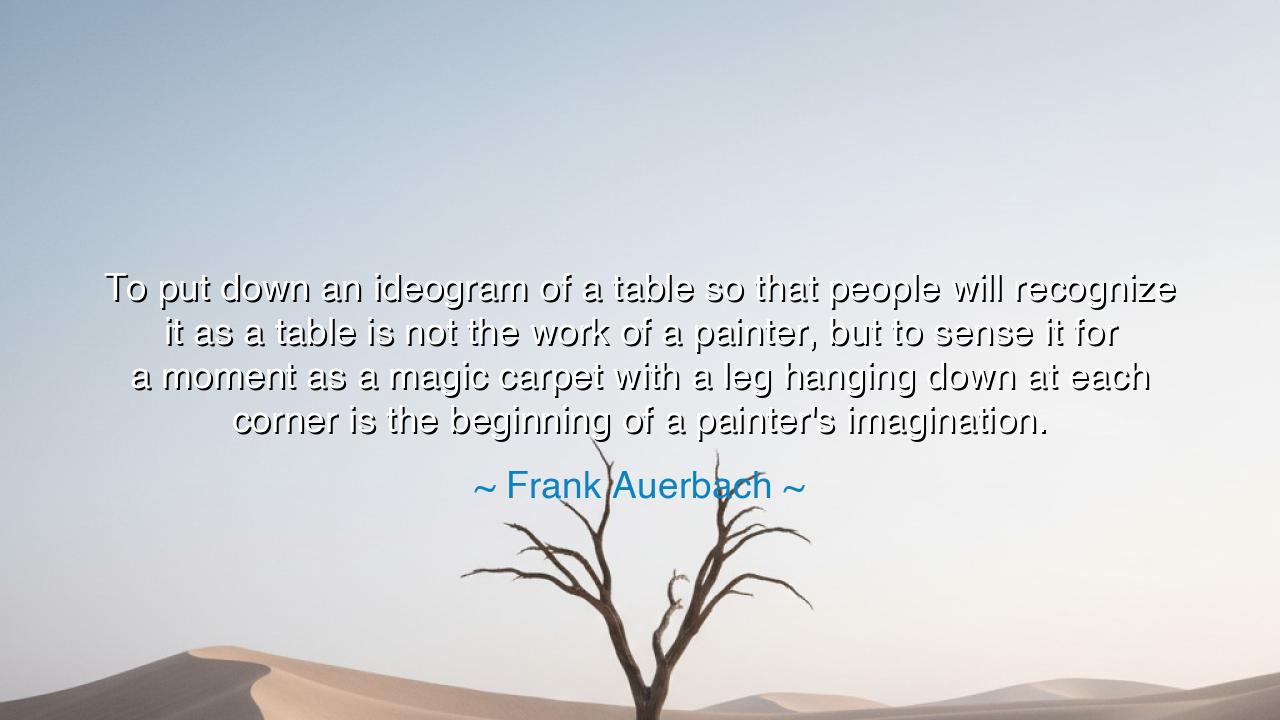
To put down an ideogram of a table so that people will recognize
To put down an ideogram of a table so that people will recognize it as a table is not the work of a painter, but to sense it for a moment as a magic carpet with a leg hanging down at each corner is the beginning of a painter's imagination.






The words of Frank Auerbach — “To put down an ideogram of a table so that people will recognize it as a table is not the work of a painter, but to sense it for a moment as a magic carpet with a leg hanging down at each corner is the beginning of a painter’s imagination.” — speak to the very essence of art, perception, and the sacred power of imagination. In this saying, Auerbach draws a line between representation and creation, between the craftsman who copies what is seen and the artist who feels what lies beneath the surface of reality. The true painter, he tells us, does not merely record what the eye perceives; he awakens what the soul knows. For where others see a table, the artist sees a magic carpet — alive, transforming, breathing with mystery.
This quote arises from Auerbach’s lifelong struggle to capture not likeness, but life itself. As one of the great British expressionists of the twentieth century, Auerbach labored with paint as though wrestling with existence. His works are dense, layered, almost sculptural — as if he were trying to pin the fleeting spirit of the world to the canvas before it vanished. When he speaks of an ideogram — a simple symbol that identifies an object — he rejects the mere imitation of things. To him, the table drawn to look like a table is lifeless; it is but a corpse of truth. But to imagine that same table as a magic carpet — hovering with energy, trembling with potential — that is to step into the realm of creation, where the painter becomes a seer.
For the imagination, as the ancients taught, is not fantasy but divine perception — the eye of the spirit that beholds what matter conceals. Plato spoke of the world of Forms, where every visible thing is but a shadow of its eternal essence. Auerbach echoes this timeless idea: the artist’s task is not to reproduce the shadow, but to reach into the light that casts it. The magic carpet is not literal; it is the artist’s way of saying that even the most ordinary object can be transfigured by vision. To sense the living magic within the mundane is the beginning of imagination, the true act of seeing.
Consider the example of Vincent van Gogh, who painted chairs, shoes, and wheat fields — yet in his hands, these humble things blazed with emotion and spirit. A chair was not a chair; it was the seat of solitude, the weight of human presence. His imagination transformed the common into the cosmic. Had he sought only to depict a chair accurately, his work would have died upon the page. But because he saw with the eyes of wonder, he revealed something deeper — the pulse of the infinite within the finite. Like Auerbach’s magic carpet, van Gogh’s ordinary objects became gateways into eternity.
Auerbach’s teaching, then, is not merely about painting — it is about how to see the world. Most people live surrounded by ideograms: symbols they recognize but do not feel. They see trees but not the trembling of life within them; they see faces but not the stories they hold. The painter, the poet, the dreamer — these are the ones who reawaken sensation, who remind the world that the ordinary is radiant. To sense something “for a moment as a magic carpet” is to pierce the veil of habit, to see the sacred shining through the familiar.
Yet this act requires courage. For to look beyond appearances is to live in continual awe — and awe, though beautiful, is not safe. It disturbs complacency. It demands attention, vulnerability, reverence. The imagination does not allow one to walk through life asleep. The painter’s eye is both a blessing and a burden, for it sees the world not as it is, but as it might become. It senses motion in stillness, eternity in the moment, and spirit in every form. To live thus is to dwell at the border between the visible and the invisible — where art, and perhaps all wisdom, begins.
Let this be the lesson for all who listen: whether you wield a brush, a pen, or simply the imagination itself, do not settle for recognition when you can seek revelation. See beyond the outline of things. Ask what they mean, not merely what they are. Train your eyes to find wonder where others find routine. For to sense the magic carpet beneath the table, to feel the tremor of mystery in the ordinary — that is not only the beginning of a painter’s imagination, but the awakening of the human soul.
And so, as the ancients would teach, art is not the making of things, but the seeing of truth. The true painter, like the true philosopher, perceives the divine thread that runs through all creation. Therefore, live as a painter of life itself — not one who sketches what is seen, but one who feels what is hidden. For every object, every person, every moment is waiting to reveal its magic — if only the imagination is brave enough to look.






AAdministratorAdministrator
Welcome, honored guests. Please leave a comment, we will respond soon